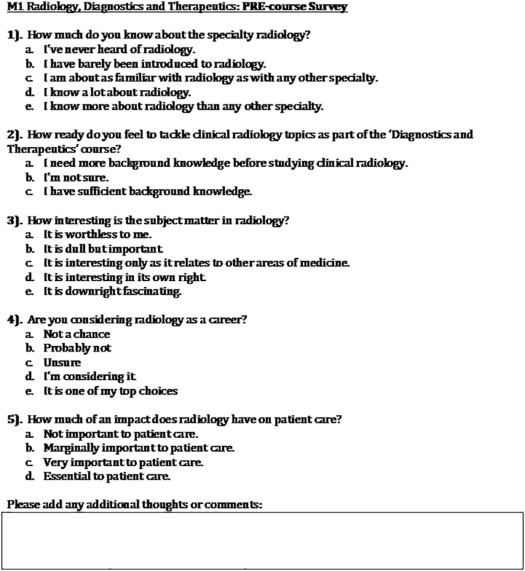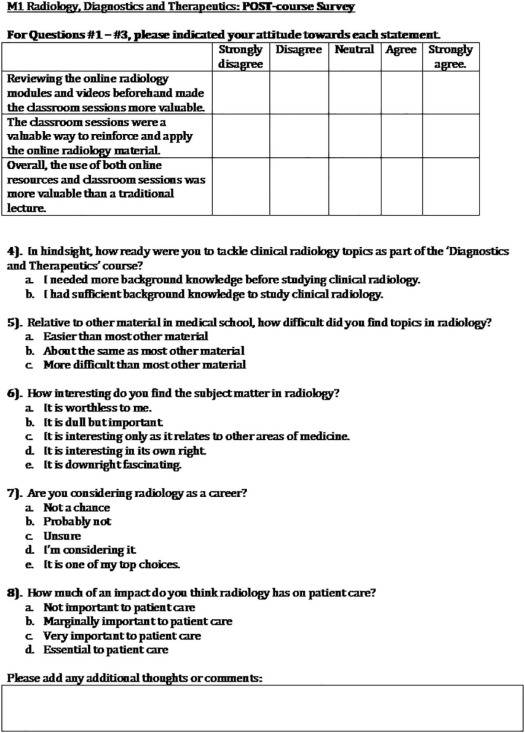Rationale and Objectives
The aims of our study were (1) to describe a new educational intervention for first-year medical students that gave a substantial, early exposure to radiology and (2) to examine how this early exposure was received by the students.
Materials and Methods
Our new curriculum incorporated a new 2-week course very early in the M1 year entitled Foundations of Diagnostics and Therapeutics. Among other topics, the course included a substantial introduction to radiology primarily through small-group seminars and online materials, administered using a flipped-classroom approach. The students were given pre- and postcourse surveys that assessed the degree to which they felt prepared to learn about radiology, as well as their interest in radiology. Results were analyzed using the Wilcoxon signed-rank test.
Results
Survey responses were obtained from 170 students before the course and 65 students afterward. Upon completing the course, students showed significantly increased academic interest in radiology ( P = .008) and a heightened perception of the effect of radiology on patient care ( P = .04), without a significant change in interest in pursuing radiology as a career. Students showed an overwhelmingly positive response to the course, although some noted that previous anatomy training would have been helpful. Eighty percent agreed or strongly agreed that the flipped-classroom structure was an effective educational model.
Conclusions
Our study demonstrated that students were very excited to gain exposure to radiology early in their medical school curriculum, and such exposure led to an improved perception of the field.
Introduction
Medical school curricula regularly undergo review and revision to stay current and relevant, a process necessitated by a growing body of scientific knowledge, evolving roles of medical providers, and expansion of technology within health-care delivery. The curriculum at the University of Michigan Medical School was recently revamped, enabling the inclusion of increased exposure to radiology, particularly in the first and second years of the 4-year program.
Traditionally, at most American medical schools, students do not receive significant exposure to radiology until their later clinical years, when they may enroll in an elective radiology rotation, as only a small number of schools have required medical imaging content taught by radiologists . However, previous research suggests that basic attitudes concerning radiology are created early in medical school and remain mostly unchanged throughout despite a later radiology elective . Furthermore, despite the increasing use of imaging for patient care, completing a rotation in radiology is required in only about 25% of US medical schools . Nevertheless, a majority of students express the desire to learn how to interpret radiographs and cross-sectional imaging studies . As the growing importance of and the desire for medical student proficiency in diagnostic radiology are recognized, there is much interest in the development of effective models for earlier and more robust incorporation of radiology within the medical school curriculum. This can be challenging, however, as radiology is an interdisciplinary subject, sitting at the intersection of anatomy, physiology, and pathology, and preclinical medical students may not have the background in these other related disciplines to appreciate the role of imaging.
Get Radiology Tree app to read full this article<
Get Radiology Tree app to read full this article<
Methods
Get Radiology Tree app to read full this article<
Course Design
Get Radiology Tree app to read full this article<
Get Radiology Tree app to read full this article<
Get Radiology Tree app to read full this article<
Get Radiology Tree app to read full this article<
Get Radiology Tree app to read full this article<
Get Radiology Tree app to read full this article<
Get Radiology Tree app to read full this article<
Get Radiology Tree app to read full this article<
Get Radiology Tree app to read full this article<
Get Radiology Tree app to read full this article<
Get Radiology Tree app to read full this article<
Get Radiology Tree app to read full this article<
Get Radiology Tree app to read full this article<
Quiz and Examination
Get Radiology Tree app to read full this article<
Get Radiology Tree app to read full this article<
Data Collection and Analysis
Get Radiology Tree app to read full this article<
Get Radiology Tree app to read full this article<
Results
Get Radiology Tree app to read full this article<
Precourse Survey
Baseline Knowledge
Get Radiology Tree app to read full this article<
TABLE 1
Precourse Survey Establishing Baseline Knowledge of Study Participants
Precourse Survey ( n = 170) How much do you know about the specialty radiology? I’ve never heard of radiology. 0 (0.0%) I have barely been introduced to radiology. 81 (47.7%) I am about as familiar with radiology as with any other specialty. 80 (47.1%) I know a lot about radiology. 8 (4.7%) I know more about radiology than any other specialty. 1 (0.6%)
Get Radiology Tree app to read full this article<
Pre- and Postcourse Survey Comparison
Perceived Preparedness
Get Radiology Tree app to read full this article<
TABLE 2
Comparison of Pre- and Postcourse Survey Results for Parallel Questions
Comparative Pre- and Postquestions Pre ( n = 170) Post ( n = 65)P Value* How ready do you feel to tackle clinical radiology topics as part of the “Diagnostics and Therapeutics” course? I need more background knowledge before studying clinical radiology. 49.4% 46.9% I have sufficient background knowledge. 4.1% 53.1% .873 I’m not sure. 46.5% NA How interesting is the subject matter in radiology? It is worthless to me. 0.0% 0.0% It is dull but important. 8.2% 3.1% It is interesting only as it relates to other areas of medicine. 32.9% 12.3% .008 It is interesting in its own right. 53.5% 69.2% It is downright fascinating. 5.3% 15.4% Are you considering radiology as a career? Not a chance. 5.9% 1.5% Probably not. 44.1% 43.1% Unsure. 32.4% 26.2% .112 I’m considering it. 16.5% 23.1% It is one of my top choices. 1.2% 6.2% How much of an impact does radiology have on patient care? Not important to patient care. 0.0% 1.5% Marginally important to patient care. 1.2% 1.5% .04 Very important to patient care. 49.1% 23.1% Essential to patient care. 49.7% 73.9%
NA, not applicable.
Wilcoxon signed-rank test.
Get Radiology Tree app to read full this article<
Get Radiology Tree app to read full this article<
Academic Interest
Get Radiology Tree app to read full this article<
Career Consideration
Get Radiology Tree app to read full this article<
Impact on Patient Care
Get Radiology Tree app to read full this article<
Postcourse Survey
Curriculum Elements
Get Radiology Tree app to read full this article<
TABLE 3
Assessing the Effectiveness of Diagnostics and Therapeutics Course Curriculum Elements
Postcourse Survey Reviewing the online radiology modules and videos beforehand made the classroom sessions more valuable. ( n = 65) Strongly disagree 1 (1.5%) Disagree 3 (4.6%) Neutral 5 (7.7%) Agree 37 (56.9%) Strongly agree 19 (29.2%) The classroom sessions were a valuable way to reinforce and apply the online radiology material. ( n = 65) Strongly disagree 1 (1.5%) Disagree 1 (1.5%) Neutral 6 (9.2%) Agree 31 (47.7%) Strongly agree 26 (40.0%) Overall, the use of both online resources and classroom sessions was more valuable than a traditional lecture. ( n = 65) Strongly disagree 2 (3.1%) Disagree 3 (4.6%) Neutral 8 (12.3%) Agree 28 (43.1%) Strongly agree 24 (36.9%) Relative to other materials in medical school, how difficult did you find topics in radiology? ( n = 64) Easier than most other materials 14 (21.9%) About the same as most other materials 43 (67.2%) More difficult than most other materials 7 (10.9%)
Get Radiology Tree app to read full this article<
Get Radiology Tree app to read full this article<
Get Radiology Tree app to read full this article<
Examination Results
Get Radiology Tree app to read full this article<
Get Radiology Tree app to read full this article<
Thematic Analysis
Precourse Survey
Get Radiology Tree app to read full this article<
Get Radiology Tree app to read full this article<
Get Radiology Tree app to read full this article<
Get Radiology Tree app to read full this article<
Get Radiology Tree app to read full this article<
Get Radiology Tree app to read full this article<
Postcourse Survey
Get Radiology Tree app to read full this article<
Get Radiology Tree app to read full this article<
Get Radiology Tree app to read full this article<
Get Radiology Tree app to read full this article<
Get Radiology Tree app to read full this article<
Get Radiology Tree app to read full this article<
Discussion
Get Radiology Tree app to read full this article<
Get Radiology Tree app to read full this article<
Get Radiology Tree app to read full this article<
Preclinical Student Preparedness for Learning Radiology
Get Radiology Tree app to read full this article<
Innovative Curriculum Elements
Get Radiology Tree app to read full this article<
Thematic Analysis of Free-text Survey Responses
Get Radiology Tree app to read full this article<
Get Radiology Tree app to read full this article<
Limitations of the Study
Get Radiology Tree app to read full this article<
Conclusions
Get Radiology Tree app to read full this article<
References
1. Straus C.M., Webb E.M., Kondo K.L., et. al.: Medical student radiology education: summary and recommendations from a national survey of medical school and radiology department leadership. J Am Coll Radiol 2014; 11: pp. 606-610.
2. Sallee D.S., Cooper C., Ravin C.E.: Medical student perceptions of diagnostic radiology. Influence of a senior radiology elective. Invest Radiol 1989; 24: pp. 724-728.
3. Poot J.D., Hartman M.S., Daffner R.H.: Understanding the US medical school requirements and medical students’ attitudes about radiology rotations. Acad Radiol 2012; 19: pp. 369-373.
4. Liu J., Tello R., Blickman J.: The radiology elective: the medical students perspective. Internet J Radiol 1999; 1:
5. Erinjeri J.P., Bhalla S.: Redefining radiology education for first-year medical students: shifting from a passive to an active case-based approach. Acad Radiol 2006; 13: pp. 789-796.
6. Arleo E.K., Bluth E., Francavilla M., et. al.: Surveying fourth-year medical students regarding the choice of diagnostic radiology as a specialty. J Am Coll Radiol 2016; 13: pp. 188-195.
7. Prezzia C., Vorona G., Greenspan R.: Fourth-year medical student opinions and basic knowledge regarding the field of radiology. Acad Radiol 2013; 20: pp. 272-283.
8. Bhogal P., Booth T.C., Phillips A.J., et. al.: Radiology in the undergraduate medical curriculum—who, how, what, when, and where?. Clin Radiol 2012; 67: pp. 1146-1152.
9. Visscher K.L., Nassrallah G., Faden L., et. al.: The exposure dilemma: qualitative study of medical student opinions and perceptions of radiology. Can Assoc Radiol J 2015; 66: pp. 291-297.
10. Branstetter B.F., Faix L.E., Humphrey A.L., et. al.: Preclinical medical student training in radiology: the effect of early exposure. AJR Am J Roentgenol 2007; 188: pp. W9-W14.
11. Branstetter B.F., Humphrey A.L., Schumann J.B.: The long-term impact of preclinical education on medical students’ opinions about radiology. Acad Radiol 2008; 15: pp. 1331-1339.
12. Murphy K.P., Crush L., O’Malley E., et. al.: Medical student perceptions of radiology use in anatomy teaching. Anat Sci Educ 2015; 8: pp. 510-517.
13. Belfi L.M., Bartolotta R.J., Giambrone A.E., et. al.: “Flipping” the introductory clerkship in radiology: impact on medical student performance and perceptions. Acad Radiol 2015; 22: pp. 794-801.

